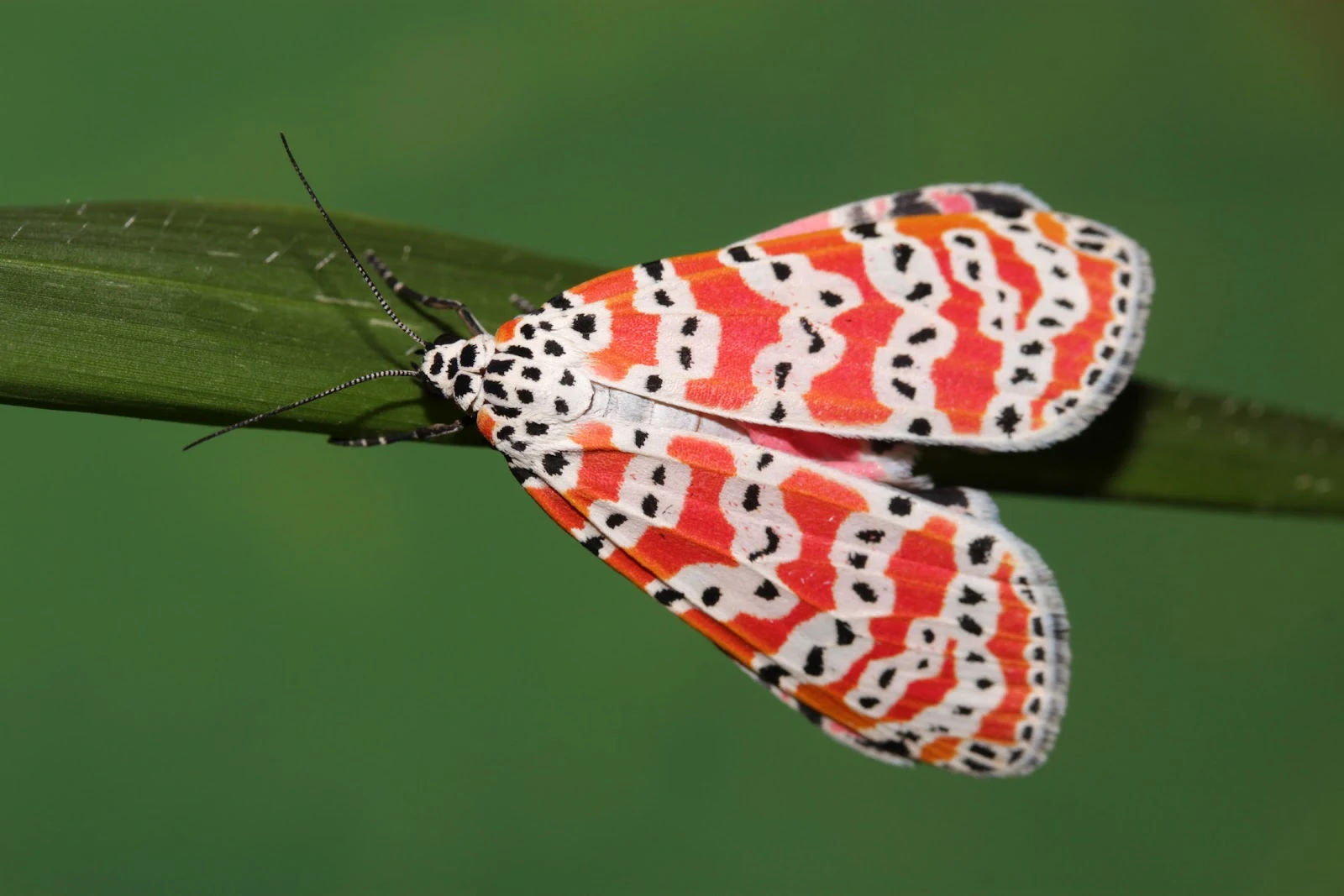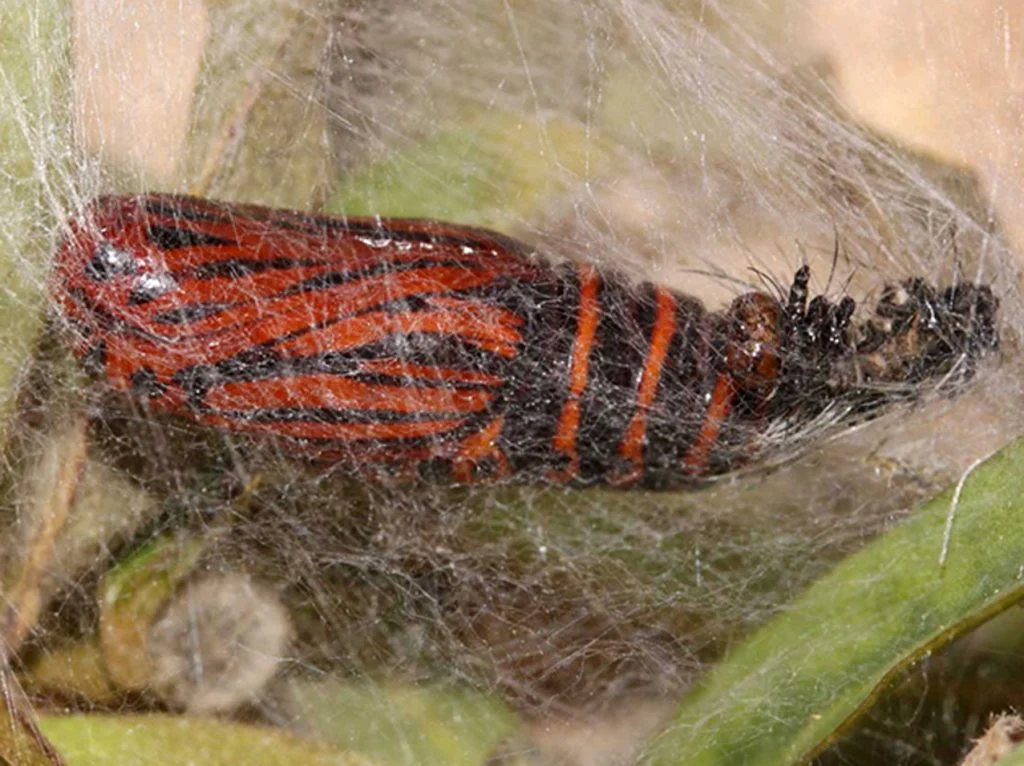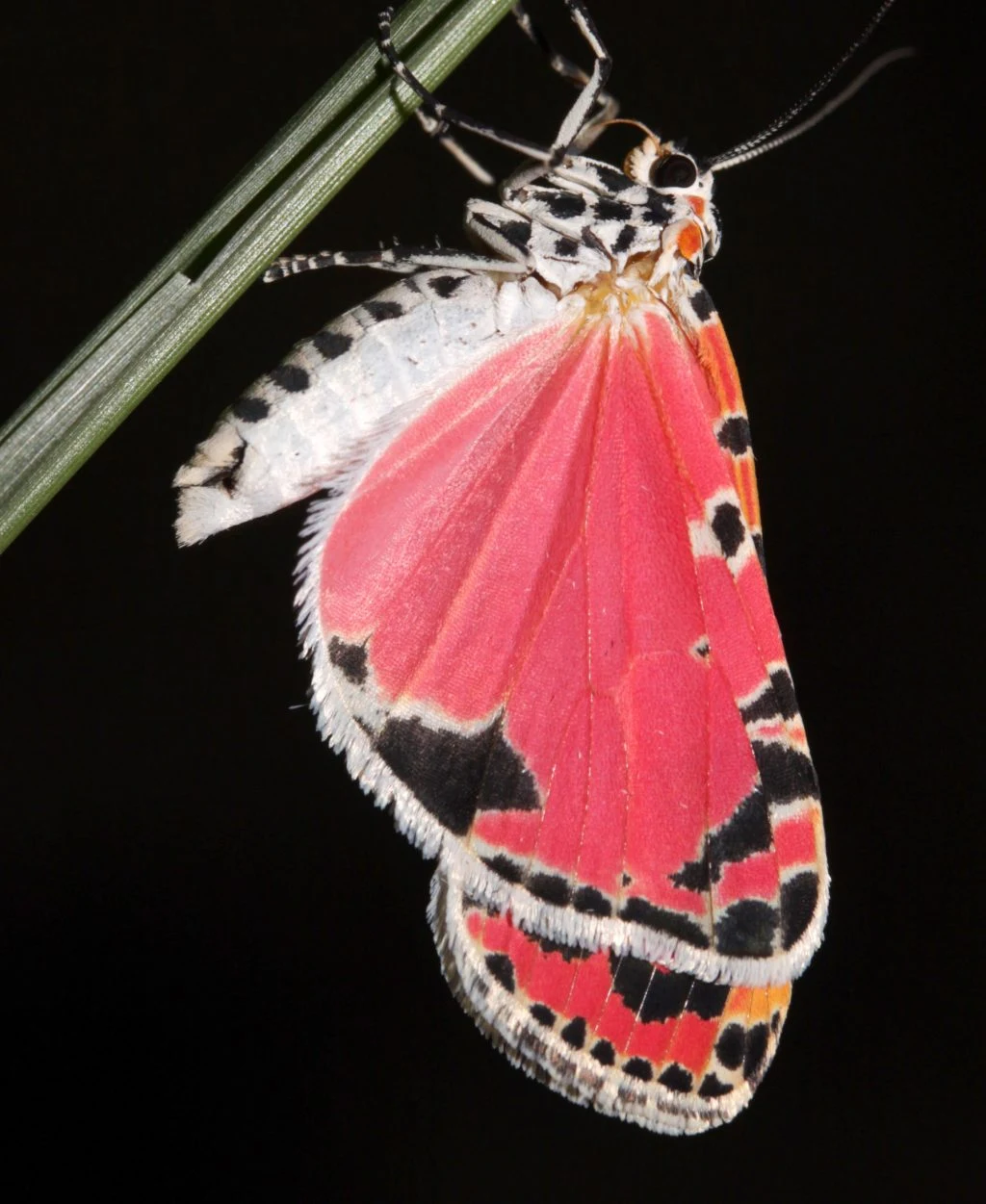Bella moths use poison to attract mates. Scientists are closer to finding out how – Research News
Imagine a man in your street who designs a brilliant defensive structure to put around your property to keep intruders out, and then invents a brilliant protective suit the intruder can wear so he or she can get through your defensive structure. He then designs an improvement in the defences that overcome the protection the suit provides, and, in a final display of madness, he brilliantly designs a remote control the intruder can use to switch off that improvement and so still burgle your property. He or she then uses the proceeds of the burglary to buy more suits and remote controls to give to friends and acquaintances so they can parasitise you too.
This is exactly the sort of mad inventor that creationists believe designs living organisms and the parasites that predate on them or, in the case of plants, eat their leaves, flowers and seeds. The plant gets given defensive chemicals that deter herbivores from eating them and even kills them if the deterrent doesn't work, and then it redesigns one of the organisms to eat the toxic plant not only with complete impunity, but to help it breed more successfully to produce more organisms to eat the toxic plant.
And it goes one step more and designs the organism so it uses the toxins to defend itself and even attract a mate! All very clever, but you can't help wondering what it’s doing it all for, exactly, and who's side is it on in these wasteful arms races of increasing complexity, like running up a down escalator in order to stand still.
An incomprehensible example of this (incomprehensible in terms of intelligent design; perfectly rational in terms of evolution by natural selection) was revealed a few days ago by researchers from the Department of Biophysics, University of Texas Southwestern Medical Center, Dallas, TX, USA together with colleagues from the Department of Biology, University of Pennsylvania, Philadelphia, PA, USA and the McGuire Center for Lepidoptera and Biodiversity, Florida Museum of Natural History, University of Florida, Gainesville, FL, USA, who have shown how the Ornate Bella moth, Utetheisa ornatrix, detoxifies the deadly toxins, Pyrrolizidine alkaloids, used as a defence against being eaten by the rattlebox plant amongst others.
And, as a further example of idiot design, the rattlebox plant concentrates its toxin in the seeds - which makes them especially attractive to the bella moth caterpillars. A 'deterrent' that encourages predators to eat its seeds!
Not only that, but the moth then becomes toxic to anything tempted to eat it as do its eggs. And to advertise how good it is at doing so, it uses the toxin to make an attractive pheromone for attracting a mate.
This was discovered by the team co-led by Andrei Sourakov of the Florida Museum of Natural History and Jing Zhang of the University of Pennsylvania who analysed the genomes of 150 museum specimens of U. ornatrix and its close relatives. In doing so they also discovered the molecular mechanisms underlying wing colour patterns.
Their research is published in PNAS, sadly behind an expensive paywall, so only the statement of significance and the abstract are available. How they did the research is described in a news release from the Florida Museum of Natural History:
Pyrrolizidine alkaloids are as bitter and toxic as they are hard to pronounce. They’re produced by several different types of plants and are among the leading causes of accidental death in cattle.
Plants that contain these alkaloids have made it very clear they don’t want to be consumed, but that hasn’t deterred bella moths (Utetheisa ornatrix). These day-flying moths exclusively eat the alkaloid-laden leaves and seeds of rattlebox plants. They then use the toxin to guard their eggs and deter predators in later life stages. They even use it to make pheromones that attract mates.
Exactly how bella moths and related species evolved the ability to safely consume pyrrolizidine alkaloids remains unknown.
In a new study published in the journal PNAS, researchers sequence the bella moth genome, which they used to pinpoint specific genes that may confer immunity to these toxins. They also sequenced genomes from 150 museum specimens — some more than a century old — to determine where bella moths and their close relatives originated. Finally, they combed through genetic data looking for clues that could help explain how the intricate wing patterns of bella moths evolved over time — the first study on moths or butterflies that has done so using dry museum collection specimens.We’ve managed to show that you can use museum specimens to answer genetic questions that normally require complicated laboratory techniques. This opens a window for future research of this kind.
Andrei Sourakov, co-lead author
McGuire Center for Lepidoptera and Biodiversity.
Florida Museum of Natural History, Gainesville, FL, USASourakov has been studying bella moths for 15 years and said sequencing the genome for this species was the natural next step in the research he’s conducted so far. Many of the insights he gained during that time came from his work with undergraduate and high school students, whom he helped conduct short experiments, analyze data for science fairs and interpret the results in peer-reviewed papers.Top left: eggs of Utetheisa ornatrix infused with toxins. Centre left: U. ornatrix caterpillar with warning coloration. Bottom left:U. ornatrix Pupa loaded with toxins accumulated as a caterpillar. Right: toxic adult U. ornatrix.
In one such project, a student set out to determine the average lifespan of bella moth adults and inadvertently stumbled across the Methuselah of the moth world.Longevity is not a critically important trait in most moth species. Many breed once, then die shortly after, either from senescence or predation. But bella moths aren’t limited by the latter, making it more likely that genes conferring increased longevity will be beneficial and passed down to the next generation.To our great surprise, they can live for up to 50 days, which is four to five times longer than the average moth.
It makes sense for something that’s chemically defended to live longer, because even if they’re caught, the predator most often lets go, and the moth can continue flying around.
Andrei Sourakov
Bella moths live throughout much of eastern North America, Central America and the Caribbean and are often active during the day. Rather than using darkness as a shroud to avoid predators, bella moths make a point of being seen. Their wings are garbed with radiant pink, pearl, onyx and sulfur yellow scales, which birds and carnivorous insects can easily spot from a distance. Any predator unlucky enough to catch a bella moth quickly corrects its mistake.
When ready to mate, females release a plume of aerosolized alkaloids derived from the plants they ate as caterpillars. Males are attracted to this scent, which they follow to its source. There, they perform a short but elaborate ritual in which they gently touch the female’s head with two fluffy and retractable structures that bear a strong resemblance to dandelions. Each filament in these structures is laced with pyrrolizidine alkaloids.Banana spiders will cut them out of their webs [wolf spiders and birds will go out of their way to avoid them]. When caught, they produce foaming liquid that tastes bad made almost entirely out of alkaloids.
Andrei SourakovIf the female decides the male has a sufficient quantity and quality of alkaloids stored up, the pair will mate. When finished, the male leaves behind a parting gift called a spermataphore, which contains sperm and, yes, more alkaloids. The female will use this and alkaloids from her own reserve to infuse the resulting eggs with toxins. This sort of biparental egg protection in insects is rare. In fact, when it was first observed in 1989 among bella moth adults, it was the only known example of a male moth or butterfly that invested any chemical resources in its progeny.Left: male U. ornatrix showing inflatable coremata, used in mating ritual. Top right: when threatened, adult bella moths exude a ball of foamy toxin. Bottom right: Rattlebox foodplant is toxic with toxins concentrated in the seeds - which the caterpillars seek out and eat.
Bella moths are able to avoid the ill effects of pyrrolizidine alkaloids by using a special enzyme that oxidizes the molecule, rendering it harmless. If a predator eats a moth, however, the process is reversed, and the alkaloid regains its potency.
Pyrrolizidine alkaloids likely first evolved as a defense mechanism in plants, which then became a commodity for moths. Sourakov and his colleagues wanted to know how bella moths acquired this detoxifying enzyme and how they maintained it through an arms race millions of years long between plant and moth.
The authors discovered bella moths have not one but two copies of the gene that codes for their unique detoxifying enzyme. They may have acquired the second through a process of gene duplication, whereby other species, including many plants, have evolved new traits.
They also found two copies of a gene partially involved in antioxidant production and defense. Sourakov suspects these genes may be related both to the ability of bella moths to detoxify alkaloids and to their remarkable longevity.
Jing Zhang, Qian Cong, Jinhua Shen, Leina Song and Nick Grishin of the University of Texas Southwestern Medical Center and Winnie Halllwachs and Daniel Janzen of the University of Pennsylvania are also authors on the study.Certain types of stress on biological systems result in a longer lifespan. It could be that the interaction bella moths have with alkaloids is not only the reason why it makes sense for them to live long lives, but also one of the mechanisms behind it.
Andrei Sourakov
SignificanceThis is just one of thousands of examples of arms races in nature which belie the childish notion of a magic omniscient super-intelligent designer designing living organisms, but few are quite so stark-staringly bonkers as this one.
Using the charismatic Bella moth as an example, we show how a genomic approach can tackle biological problems. We assembled a reference genome and obtained genomic datasets for more than a hundred specimens of Bella moth and its close relatives across the World. Through comparative analysis of these sequence datasets, we uncovered molecular mechanisms underlying wing pattern diversity in populations of the moth and showcasing the relevance of museum collection specimens that we sequenced. We infer the role of the cortex gene in regulating forewing spots and the possible involvement of lim3 in determining the hindwing coloration. We have gained insights into the adaptive processes associated with unique biological traits, including detoxification abilities.
Abstract
The Ornate Moth, Utetheisa ornatrix, has served as a model species in chemical ecology studies for decades. Like in the widely publicized stories of the Monarch and other milkweed butterflies, the Ornate Moth and its relatives are tropical insects colonizing whole continents assisted by their chemical defenses. With the recent advances in genomic techniques and evo-devo research, it is becoming a model for studies in other areas, from wing pattern development to phylogeography, from toxicology to epigenetics. We used a genomic approach to learn about Utetheisa’s evolution, detoxification, dispersal abilities, and wing pattern diversity. We present an evolutionary genomic analysis of the worldwide genus Utetheisa, then focusing on U. ornatrix. Our reference genome of U. ornatrix reveals gene duplications in the regions possibly associated with detoxification abilities, which allows them to feed on toxic food plants. Finally, comparative genomic analysis of over 100 U. ornatrix specimens from the museum with apparent differences in wing patterns suggest the potential roles of cortex and lim3 genes in wing pattern formation of Lepidoptera and the utility of museum-preserved collection specimens for wing pattern research.
Zhang, Jing; Cong, Qian; Shen, Jinhui; Song, Leina; Hallwachs, Winnie; Janzen, Daniel H.; Sourakov, Andrei; Grishin, Nick V.
What one genus of showy moths can say about migration, adaptation, and wing pattern
Proceedings of the National Academy of Sciences (2024) 121(17) e2319726121; DOI: 10.1073/pnas.2319726121
© 2024 PNAS.
Reprinted under the terms of s60 of the Copyright, Designs and Patents Act 1988.
On the other hand, this is exactly the sort of thing that the mindless, utilitarian process of evolution by natural selection can produce. Indeed, it would be a sign of intelligent intervention if these arms races didn't exist since all they do is add layers of complexity and waste for no ultimate gain that no intelligent design process would produce.
The Unintelligent Designer: Refuting The Intelligent Design Hoax
The Malevolent Designer: Why Nature's God is Not Good
Illustrated by Catherine Webber-Hounslow.













No comments :
Post a Comment
Obscene, threatening or obnoxious messages, preaching, abuse and spam will be removed, as will anything by known Internet trolls and stalkers, by known sock-puppet accounts and anything not connected with the post,
A claim made without evidence can be dismissed without evidence. Remember: your opinion is not an established fact unless corroborated.